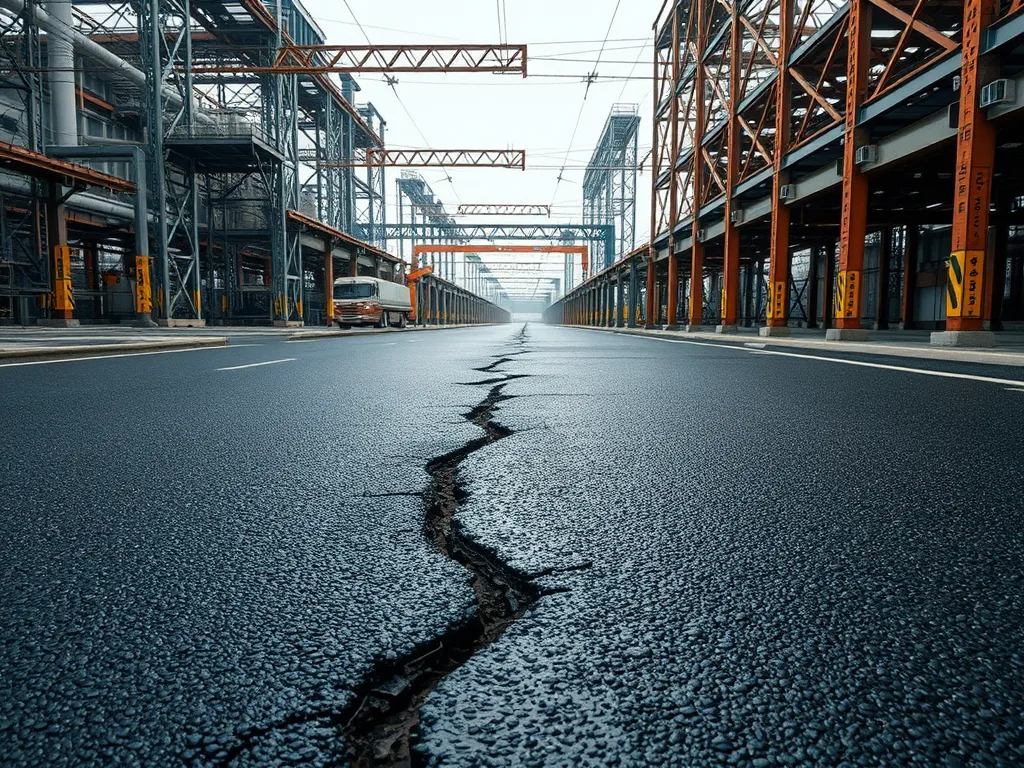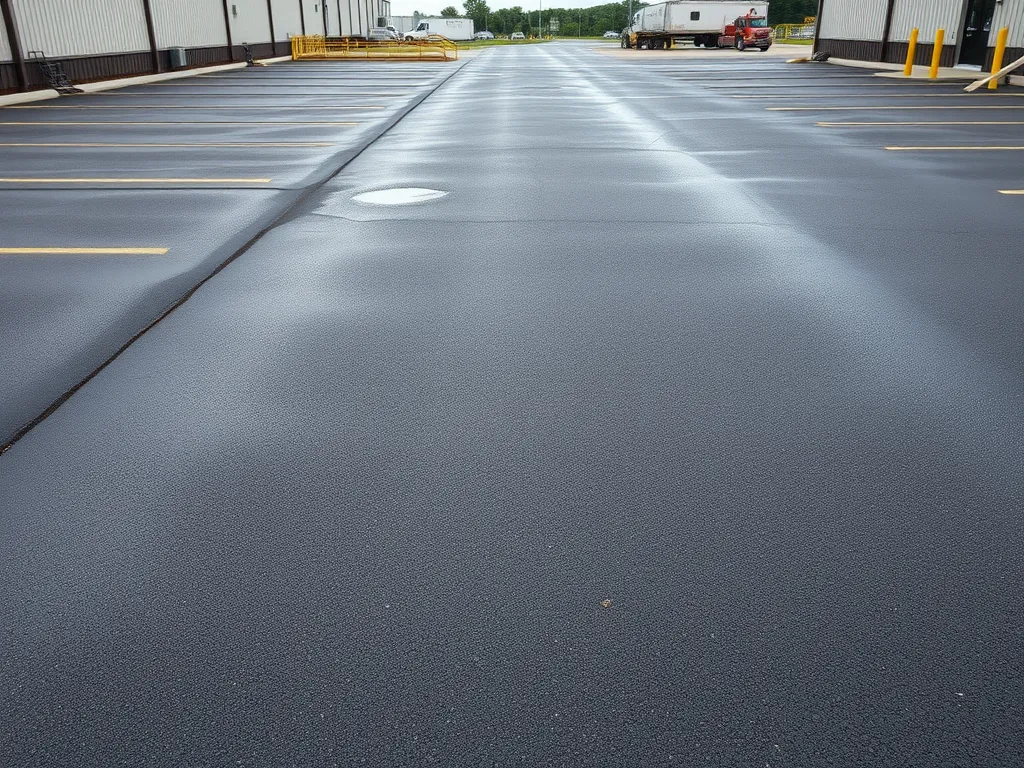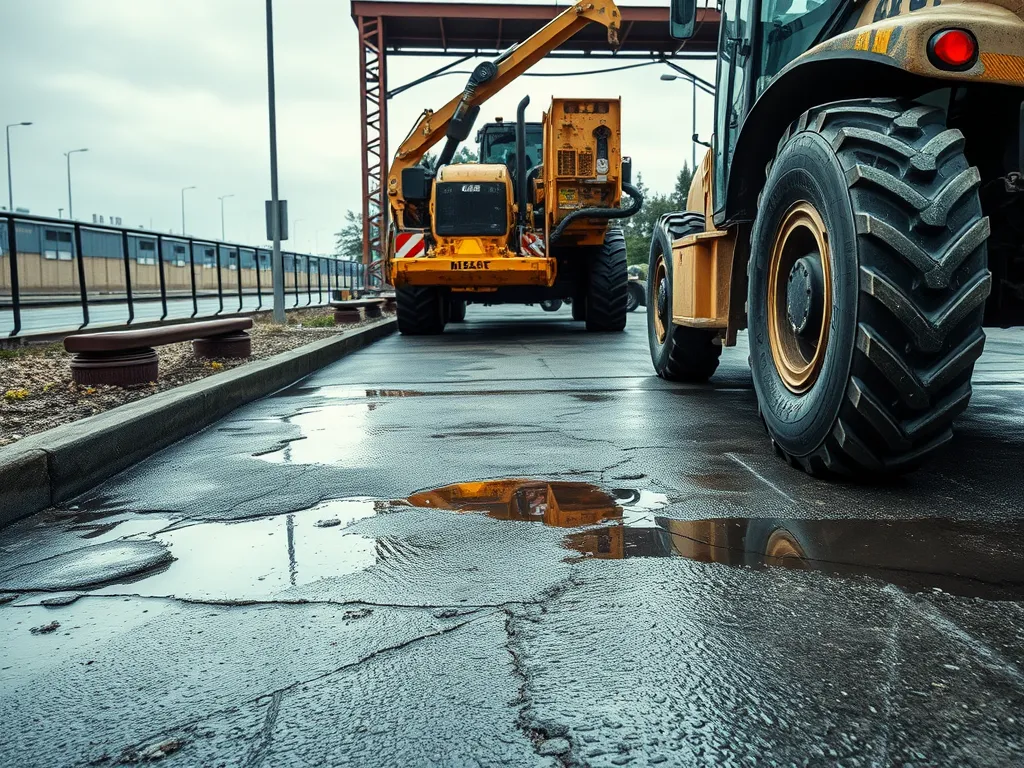Average Lifespan Of Sealcoated Asphalt: Key Factors & Longevity Tips
Published on: August 17, 2025 | Last Updated: April 14, 2025
Written By: George Voss
Sealcoated asphalt typically lasts 3-5 years for residential driveways and 1-3 years for commercial parking lots before requiring reapplication. This protective layer shields asphalt from UV rays, water damage, and oil spills while maintaining surface flexibility. Lifespan varies based on climate, traffic volume, and sealant quality – with proper maintenance extending protection by up to 30% compared to untreated surfaces.
This article breaks down how sealcoating works, why longevity ranges differ, and proven strategies to maximize results. You’ll learn about weather impacts, material choices like coal tar versus asphalt-based sealers, and application techniques that affect durability. We’ll compare maintenance costs for sealed versus unsealed pavements and show how to spot early warning signs of wear.
Contents
- Understanding Sealcoated Asphalt Lifespan
- How Sealcoating Extends Asphalt Longevity
- Factors Influencing Sealcoating Longevity
- Average Lifespan Ranges
- Maximizing Sealcoating Duration
- Sealcoated Vs Unsealed Asphalt Comparison
- Calculating Sealcoating Needs
- Common Longevity Challenges
- Frequently Asked Questions
- Closing Thoughts
- Additional Resources for You:
Understanding Sealcoated Asphalt Lifespan
Sealcoating shields paved surfaces using specialized protective coatings. This process involves spraying or brushing liquid sealants onto existing asphalt. The mixture typically contains refined coal tar, polymer-modified asphalt emulsions, or petroleum-based binders blended with sand for traction.
What is Sealcoating and How Does It Protect Asphalt?
Sealcoating creates a barrier against elements threatening pavement integrity. UV rays degrade bitumen – the glue holding asphalt together – causing brittleness. Sealants block 99% of ultraviolet radiation, slowing oxidation. They repel motor oil, transmission fluid, and deicing chemicals that break down pavement bonds. Properly sealed surfaces shed water efficiently, minimizing freeze-thaw damage common in northern states.
Primary Purpose Of Asphalt Sealants
Extending functional pavement life drives sealcoating use. Unprotected asphalt degrades 3x faster due to weather exposure. Sealants add 5-7 years to surfce life when reapplied every 3 years. Commercial lots with heavy traffic require more frequent treatments (1-2 years) versus residential drives (2-4 years). High-quality sealcoats restore flexibility, filling micro-cracks before they expand into structural failures.
Next, we examine how specific protective mechanisms combat common asphalt killers. [Segue into next section without transitional phrases]
How Sealcoating Extends Asphalt Longevity
Sealcoating adds years to asphalt by fighting its top enemies. This thin layer acts like armor against daily wear and weather harm.
Protection Against Oxidation and UV Damage
Sun rays and air break down asphalt’s sticky binder over time. Sealcoating blocks 80% of UV light and slows binder decay. Unprotected asphalt turns gray and brittle in 6-12 months. Sealed surfaces stay black and flexible for 2-5 years.
Resistance to Fluid Penetration (Oil, Gasoline, Water)
Asphalt soaks up fluids like a sponge. One quart of gas can eat through 3 sq.ft. of unsealed pavement. Sealcoating fills tiny holes, stopping 90% of leaks. This keeps the base layer dry and stops potholes from forming.
Enhanced Surface Flexibility to Prevent Cracking
Heat makes asphalt swell. Cold makes it shrink. These changes create cracks without a shield. Sealcoats bend with the pavement, like rubber on a tire. High-grade sealants with 15-20% polymers add stretch to handle temperature swings from -20°F to 120°F.
While sealcoating offers strong defense, its staying power depends on climate, traffic, and mix quality. Next, we break down how these forces shape your pavement’s timeline.

Factors Influencing Sealcoating Longevity
Multiple variables determine how long sealed surfaces remain protective. Let’s break down the most critical elements impacting performance timelines.
Climate and Weather Exposure
Regional weather patterns create distinct challenges. Northern states face different threats than sunbelt regions.
Impact of freeze-thaw cycles
Water infiltration expands by 9% when freezing inside cracks. Repeated cycles break bond lines between sealant and pavement. One harsh winter can cut projected lifespans by 40% in vulnerable areas.
Effects of heavy rainfall or extreme heat
UV radiation degrades binders at 158°F+ pavement temps. Torrential rains erode fresh sealcoats – 2″ of downpour within 48 hours of application reduces effectiveness by 15%.
Traffic Volume and Usage Patterns
Driveways handling 2-4 vehicles daily typically outlast commercial lots with 200+ trips. Turning movements grind sealcoats 30% faster than straight-line traffic. Delivery trucks cause 5x more wear than sedans.
Quality Of Sealant Materials
Not all sealers perform equally. Premium mixes contain 35-45% solids versus budget options at 20-25%. Higher solids mean thicker protective films.
Coal tar vs asphalt-based sealers
| Type | Lifespan | Cost/SF |
|---|---|---|
| Coal tar | 3-5 years | $0.12-$0.18 |
| Asphalt-based | 2-3 years | $0.08-$0.14 |
Coal tar resists oil spills better but faces environmental restrictions in 12 states.
Application Thickness and Technique
Proper surface prep ensures better bonding. Squeegee methods lay 1/8″ films – spray systems often deposit just 0.06″. Industry standards require minimum 0.10″ thickness for full protection.
These variables directly impact the numbers in our next section covering typical lifespan ranges for different use cases.
Also See: Commercial Vs Residential Asphalt Maintenance: Key Differences
Average Lifespan Ranges
Sealcoated asphalt lifespan varies based on surface type and use. Residential driveways typically outlast commercial surfaces due to lower traffic demands. Weather patterns, material quality, and maintenance habits also shape these timelines.
Residential Driveways: 2-5 Years
Home driveways with proper sealcoating last 2-5 years. Light vehicle traffic allows the coal tar or asphalt-based sealer to maintain flexibility. Areas with minimal snowplow use or heavy equipment see extended performance. Annual inspections help spot early aggregate exposure or UV damage.
Commercial Parking Lots: 1-3 Years
Parking lots require reapplication every 1-3 years. Constant vehicle turns, delivery trucks over 10,000 lbs, and oil spills degrade sealants faster. High-traffic zones near entrances show wear first. Facilities using de-icing chemicals may need yearly sealing to combat accelerated erosion.
Signs Of Diminished Effectiveness
Fading to light gray signals UV breakdown. Hairline cracks wider than 1/4 inch indicate lost flexibility. Pooling water or fuel stains prove reduced fluid resistance. Rough textures suggest aggregate loss – a clear cue for resealing. Alligator cracks or raveling aggregate mean immediate action prevents base layer damage.
Recognizing these signs early helps plan cost-effective maintenance before structural repairs become needed. Up next: proven strategies to stretch sealcoating durability through surface prep and application timing.

Maximizing Sealcoating Duration
Get more years from your sealcoat with smart care steps. Focus on timing, prep work, and aftercare to boost performance.
Ideal Application Frequency
Apply sealcoat every 2-3 years for best results. High-traffic lots need it yearly. Watch for fading or cracks as signs to redo. Missed cycles cut seal coated asphalt life by 40%.
Proper Surface Preparation Requirements
Clean drives well before sealing. Fix cracks wider than 1/4 inch. Remove oil spots with degreaser. Let surface dry 24 hours. Poor prep leads to fast peel-offs.
- Sweep dirt with stiff broom
- Pressure wash at 2500 PSI
- Fill cracks with rubberized filler
Curing Time and Post-application Care
Wait 24-48 hours before driving on new seal. Heat above 70°F speeds drying. Avoid sharp turns for 5 days. Fix leaks fast – gas eats sealant in hours.
- Block traffic with cones
- No car washes for 7 days
- Reapply every 18 months in snow zones
Smart upkeep keeps sealants strong. Now see how sealed vs bare asphalt stacks up over time.
Sealcoated Vs Unsealed Asphalt Comparison
Sealcoating adds years to asphalt surfaces by creating a protective shield. Unsealed asphalt faces faster degradation from weather, chemicals, and traffic wear. Let’s break down lifespan differences and cost impacts.
Lifespan Difference Analysis
Sealcoated asphalt lasts 12-15 years with proper maintenance, while unsealed surfaces degrade in 8-10 years. The sealant blocks UV rays that break down binder materials, slowing surface erosion. Water penetration drops by 70-80% in sealed pavements, reducing freeze-thaw damage. Sealed surfaces also resist gasoline and oil spills that dissolve asphalt binders.
Unsealed asphalt shows cracks within 3-5 years. These cracks widen quickly without sealant’s flexible barrier. A University of Texas study found sealed driveways retain 95% structural integrity after 7 years versus 65% for unsealed ones.
Long-term Maintenance Cost Comparison
Resealing costs $0.15-$0.25 per square foot every 2-5 years. Unsealed asphalt requires crack filling annually at $1-$3 per linear foot, plus $2-$5 per square foot for patching every 3 years. Over 15 years, sealed surfaces cost 40-60% less in repairs.
Commercial lots with sealcoating save $1,200-$3,800 annually in maintenance. Heavy traffic areas see faster returns – sealed warehouse aprons last 3x longer between resurfacing. Insurance claims for trip hazards drop 22% on sealed properties due to smoother surfaces.
Proper maintenance frequency depends on material choices and climate conditions. Next, we’ll show how to calculate your exact sealcoating needs.

Calculating Sealcoating Needs
Proper calculation methods directly impact how long your sealcoating lasts. Accurate measurements ensure full protection without material waste or thin coverage that reduces lifespan.
Measuring Coverage Area
Calculate square footage using length × width for rectangular surfaces. Irregular shapes require dividing into sections and summing totals. A 20’x50′ driveway needs 1,000 sq ft of sealant. Underestimating leads to premature wear – a key reason seal coated asphalt lifespan varies between properties.
Determining Application Frequency
Residential driveways typically need recoating every 2-3 years. High-traffic commercial lots may require annual applications. Consider three factors:
- Daily vehicle counts (4+ cars/day = faster degradation)
- Climate severity (4+ freeze-thaw cycles cut lifespan by 30%)
- Sealer type (coal tar lasts 3-5 years vs asphalt-based’s 2-4 years)
Estimating Material Requirements
Standard sealcoat covers 50-80 sq ft per gallon per coat. A 1,500 sq ft parking lot needing two coats requires 37.5-60 gallons. Thinner applications below 0.1″ thickness reduce sealcoat lifespan by up to 18 months. Bulk pricing averages $0.15-$0.25 per sq ft including labor.
With precise calculations handled, the next challenge becomes recognizing when environmental factors threaten your sealant’s performance.
Common Longevity Challenges
Even with proper care, sealcoated asphalt faces threats that cut its lifespan short. Spotting these issues early keeps surfaces strong for more years.
Premature Wear Patterns
Wear shows up fast when sealcoats fail. Watch for two key signs:
Cracking or flaking sealant
Hairline cracks let water seep under layers. Flakes form when bond fails, leaving raw asphalt open to sun and rain. Fix small cracks fast – they grow 300% wider in one freeze-thaw cycle.
Fading and color loss
UV rays bleach black sealcoats gray in 12-18 months. Faded spots lose 40% of their shield power. Coal tar blends keep color 2x longer than asphalt-based sealers.
Environmental Stressors
Nature and use test sealcoats daily. Two big risks:
Chemical exposure risks
Gas, oil, and road salts eat through seal layers. One fuel spill cuts local lifespan by 60%. Wash spills fast – acids break bonds in 72 hours.
Heavy equipment impacts
Dump trucks and plows scrape thin coats. A 10,000-pound load can crack fresh sealant in weeks. Use 3/8″ thick coats near loading zones – lasts 2.5x longer than thin layers.
These threats show why smart care beats simple fixes. Next, we break down real-world time frames for driveways, lots, and more.

Frequently Asked Questions
How Long Should Asphalt Sealcoating Last?
The longevity of asphalt sealcoating typically ranges between 2 to 5 years, depending on usage and maintenance. High-traffic commercial areas may require reapplication every 1 to 3 years.
What is the Life Expectancy Of a Blacktop Driveway?
A blacktop driveway can last approximately 15-20 years when well-maintained, but this can be reduced to 8-10 years without sealcoating or proper maintenance.
How Long Does Driveway Sealer Last in a Bucket?
Driveway sealer can last up to two years in a sealed bucket if stored properly, away from extreme temperatures and direct sunlight. Once opened, it’s best to use it within a few months to ensure effectiveness.
How Long Does Sealcoating Take to Dry?
Sealcoating typically takes 24 to 48 hours to dry completely, depending on weather conditions. It’s advisable to avoid driving on the newly sealed surface for at least 24 hours to ensure the integrity of the coating.
Closing Thoughts
The average lifespan of sealcoated asphalt varies significantly based on several factors. Residential driveways can last between 2 to 5 years, while commercial parking lots typically range from 1 to 3 years. Key variables influencing lifespan include climate conditions, traffic volume, and the quality of sealants used.
Regular maintenance can greatly enhance longevity. Timely inspections, prompt crack repairs, and appropriate reapplication intervals help preserve the sealant’s protective qualities.
For further details on optimizing your asphalt maintenance and longevity strategies, visit Asphalt Calculator USA.


